When I first shared these signature Garden Betty recipes 12 years ago, an impending long road trip (and a veritable “field” of overgrown volunteer tomato plants) were the impetus for finding the quickest and easiest way to save and store my bumper crop of tomatoes.
Preserving ripe tomatoes is easy enough (after all, you can never have too much homemade tomato sauce or dehydrated tomatoes), but what to do about green, unripe tomatoes—and lots of them?
Enter: pickled green tomatoes.

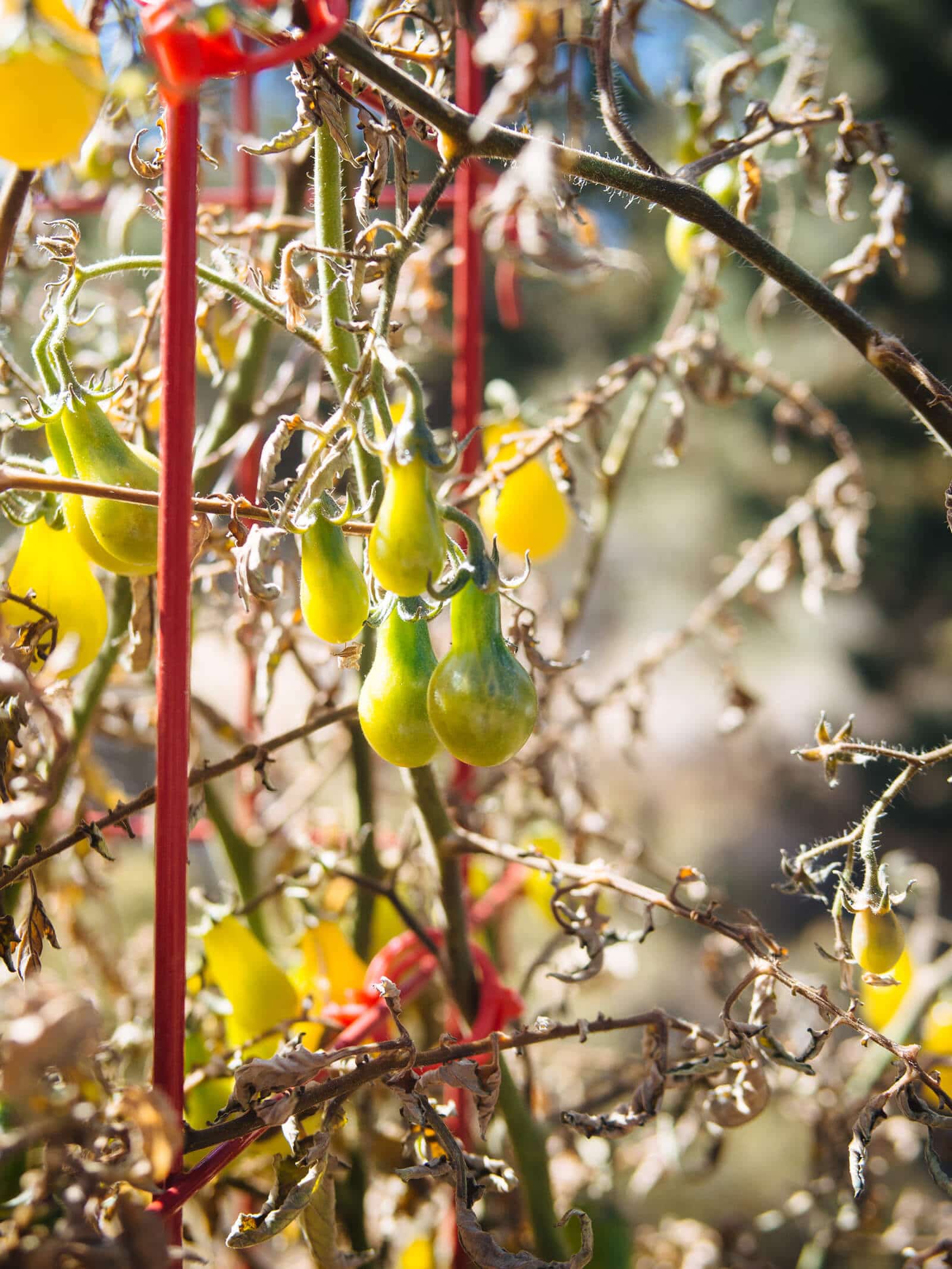
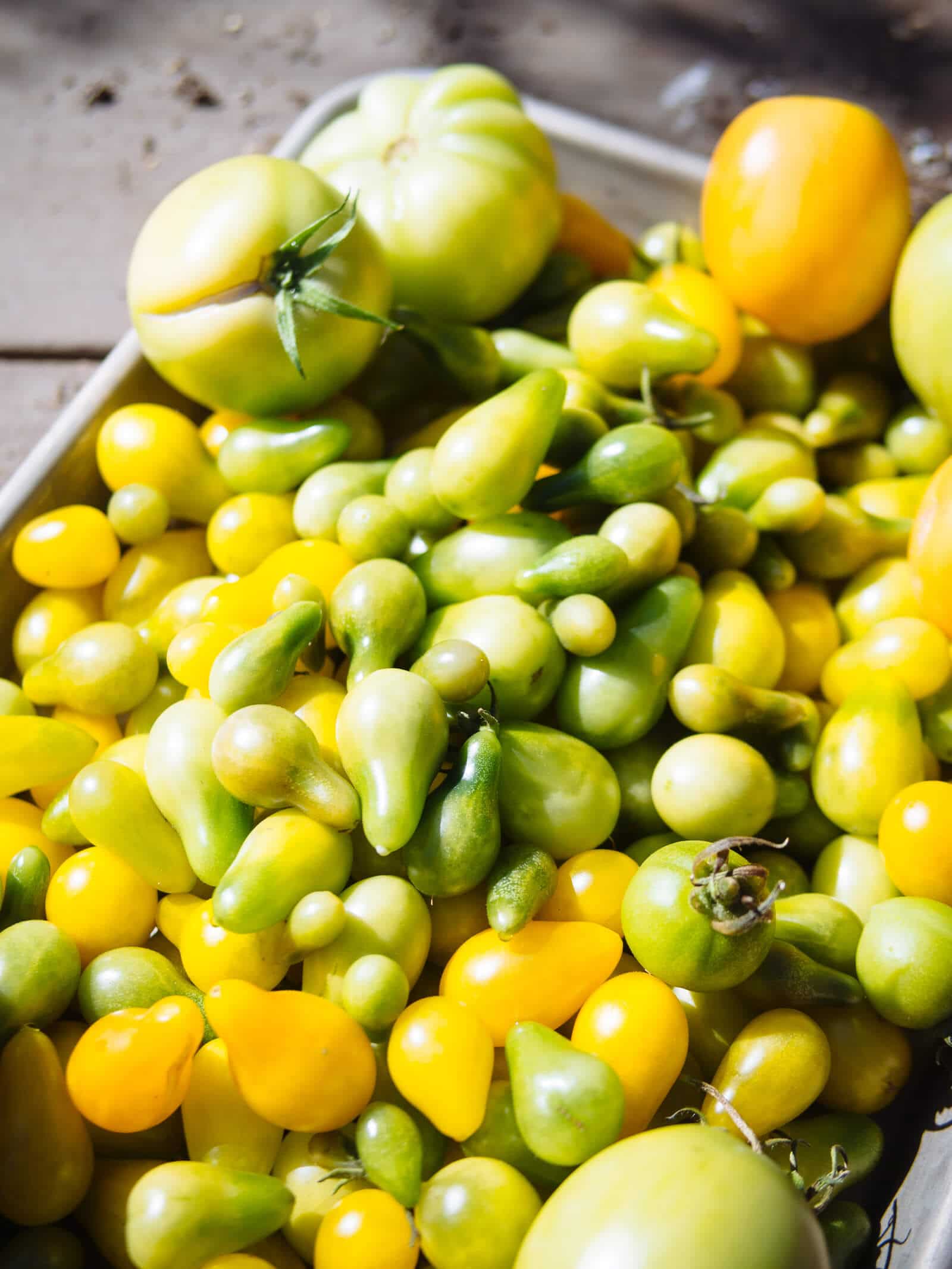
That week, I walked into the garden and saw hundreds of green tomatoes hanging off the vines, just days away from ripening (and guaranteed to overripen by the time I returned from my trip).
My first thought was… Who’s gonna eat all of that?! (I certainly didn’t want to leave them for the raccoons!)
And so, just three days before I was set to depart, I spent an afternoon picking as many green cherry tomatoes off my plants as I could, hoping to preserve them so I wouldn’t come home to a mass of mushy, rotting fruit.
The final tally came to 55 pounds.
When you’re talking about cherry tomatoes, 55 pounds is a lot of tomatoes. I nearly tweaked my back hauling the harvest from the garden up to the house. (I know, I know—cue the violins.)
Related: Grow Tomatoes Like a Boss With These 10 Easy Tips
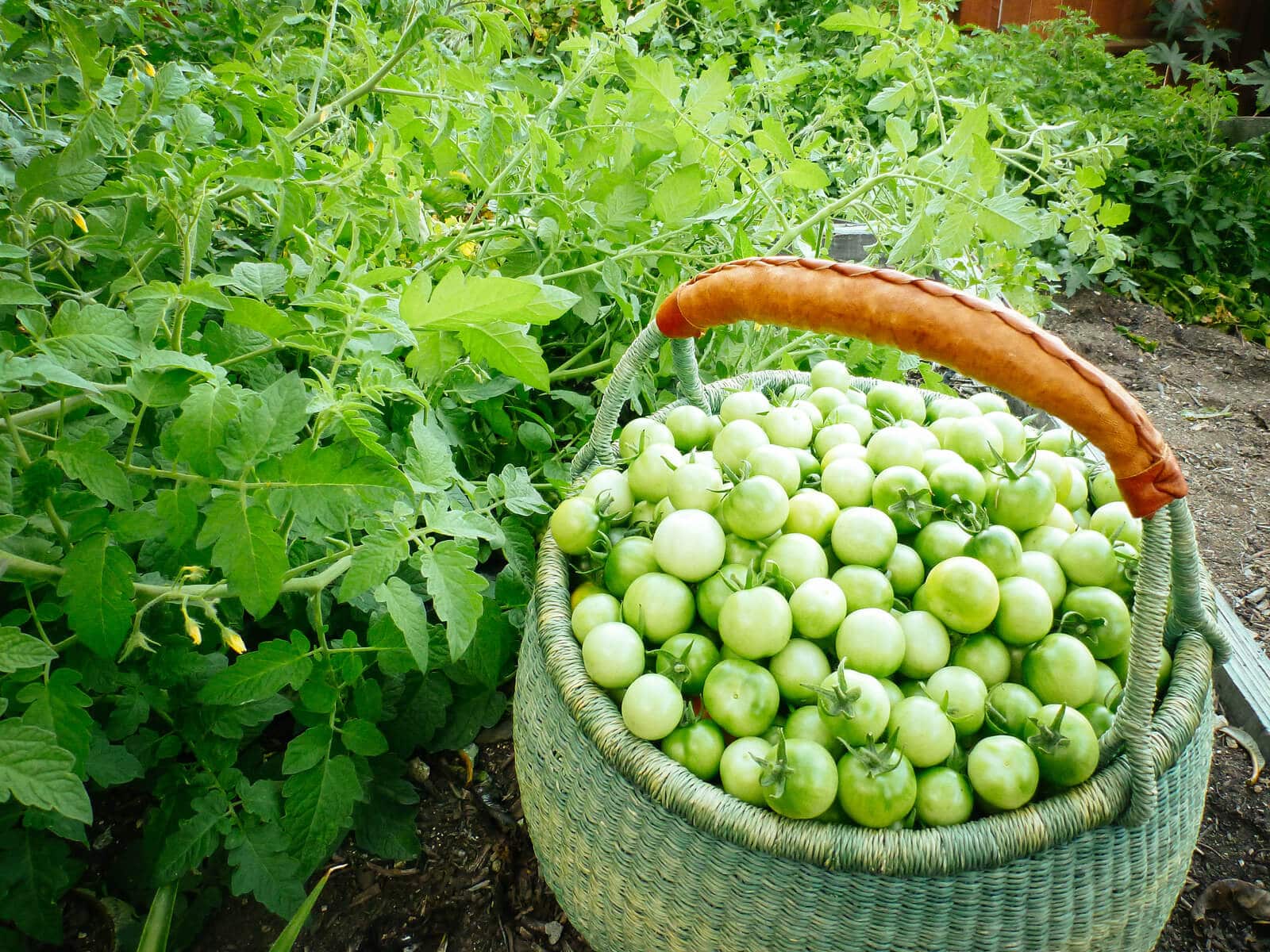
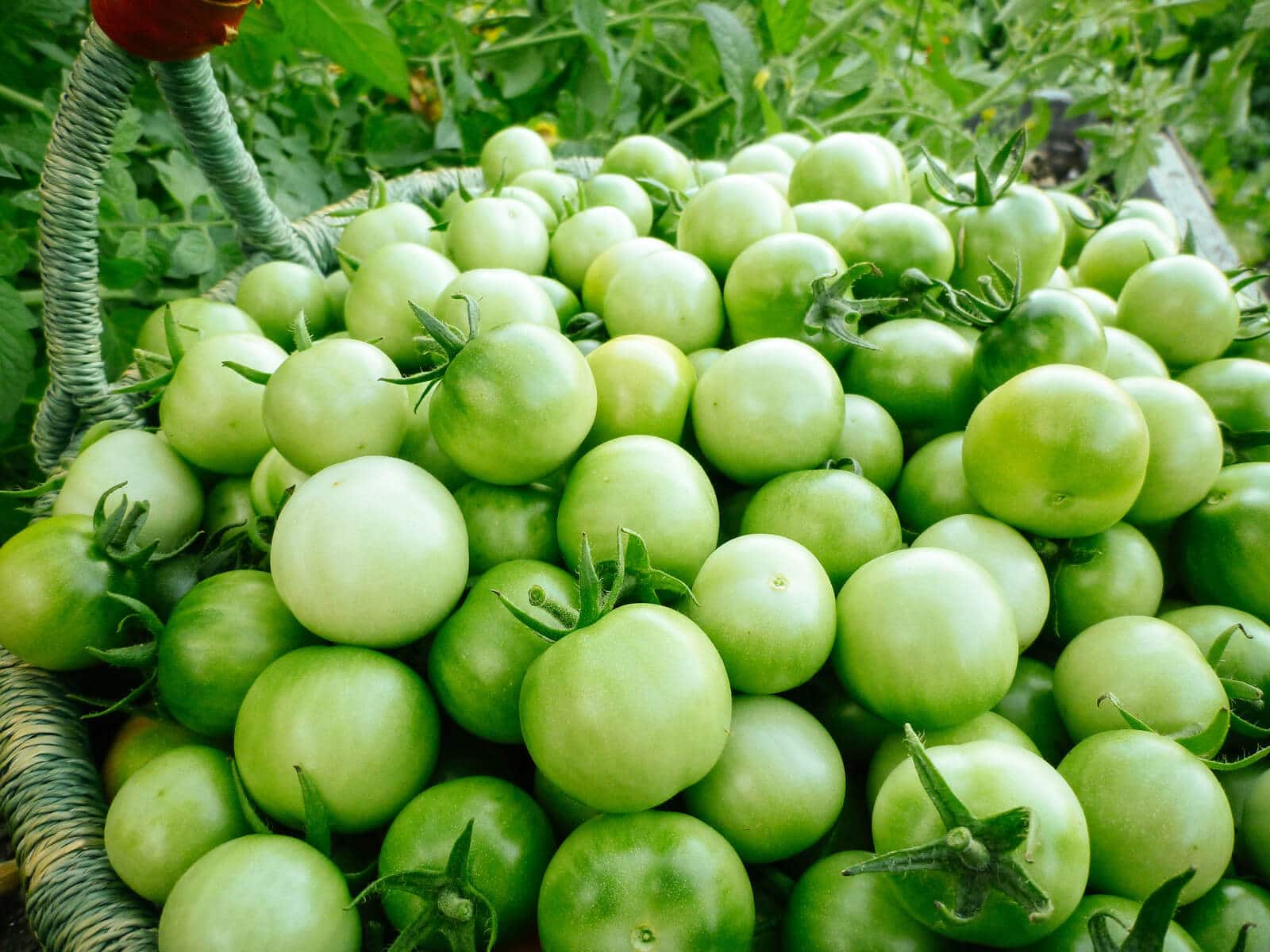
Since I didn’t have time to get creative and whip up some relish or chutney, I decided to pickle all of them, thinking I can always turn those preserved tomatoes into relish later on.
And because I was canning up a storm (32 quarts in all), I pickled them four different ways so I wouldn’t get too sick of them come next summer.
Read more: 9 *Updated* Canning Tips and Tricks for Modern-Day Home Canning
Guess what everybody’s getting for Christmas this year?

Disclosure: If you shop from my article or make a purchase through one of my links, I may receive commissions on some of the products I recommend.
How to make pickled green tomatoes, 4 ways
Makes 1 quart
Ingredients
1 pound green slicing tomatoes (or 1 1/2 pounds green cherry tomatoes)
For the Brine
1 cup white distilled vinegar (5% acidity)
1 cup water
1 tablespoon kosher salt
Basic Pickling Spice Mix
1 teaspoon yellow mustard seeds
1 teaspoon celery seeds
1 teaspoon coriander seeds
1/2 teaspoon black peppercorns
1/2 teaspoon whole allspice
Dilly Garlicky Pickling Spice Mix
2 teaspoons dill seeds
1 teaspoon black peppercorns
1 bay leaf
4 garlic cloves, peeled
Hot ‘n Spicy Pickling Spice Mix
1 teaspoon black peppercorns
1 teaspoon Szechuan peppercorns *
1 teaspoon brown mustard seeds
1/2 teaspoon coriander seeds
1/2 teaspoon red pepper flakes
Curried Pickling Spice Mix **
1/4 cup packed brown sugar
1 teaspoon curry powder
1/4 teaspoon cumin seeds
1/4 teaspoon whole allspice
3/4 inch fresh ginger, sliced into thin coins
Instructions
Cut larger (slicing) tomatoes into 1/2-inch wedges, and cut smaller (cherry or grape) tomatoes in half.
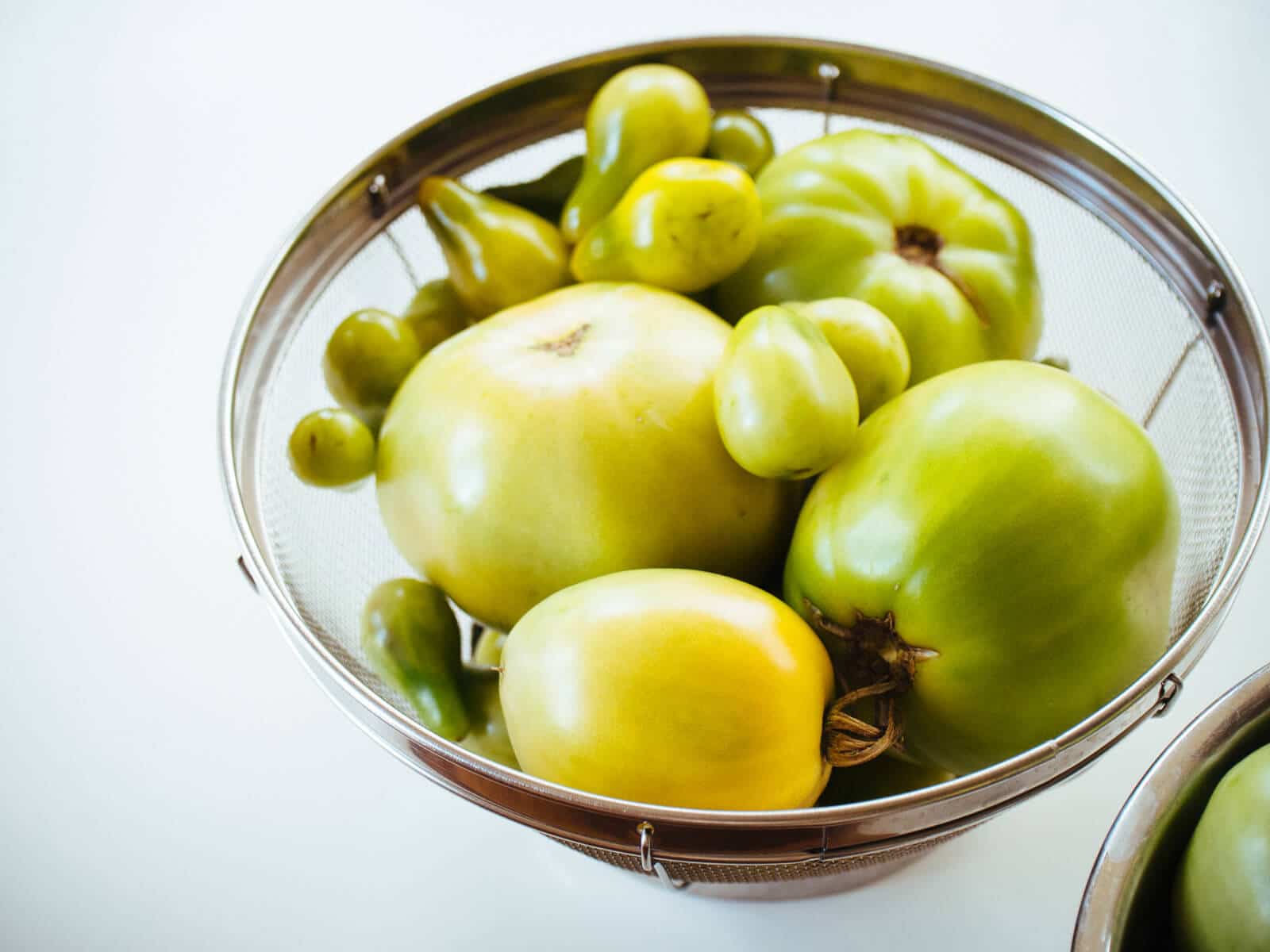
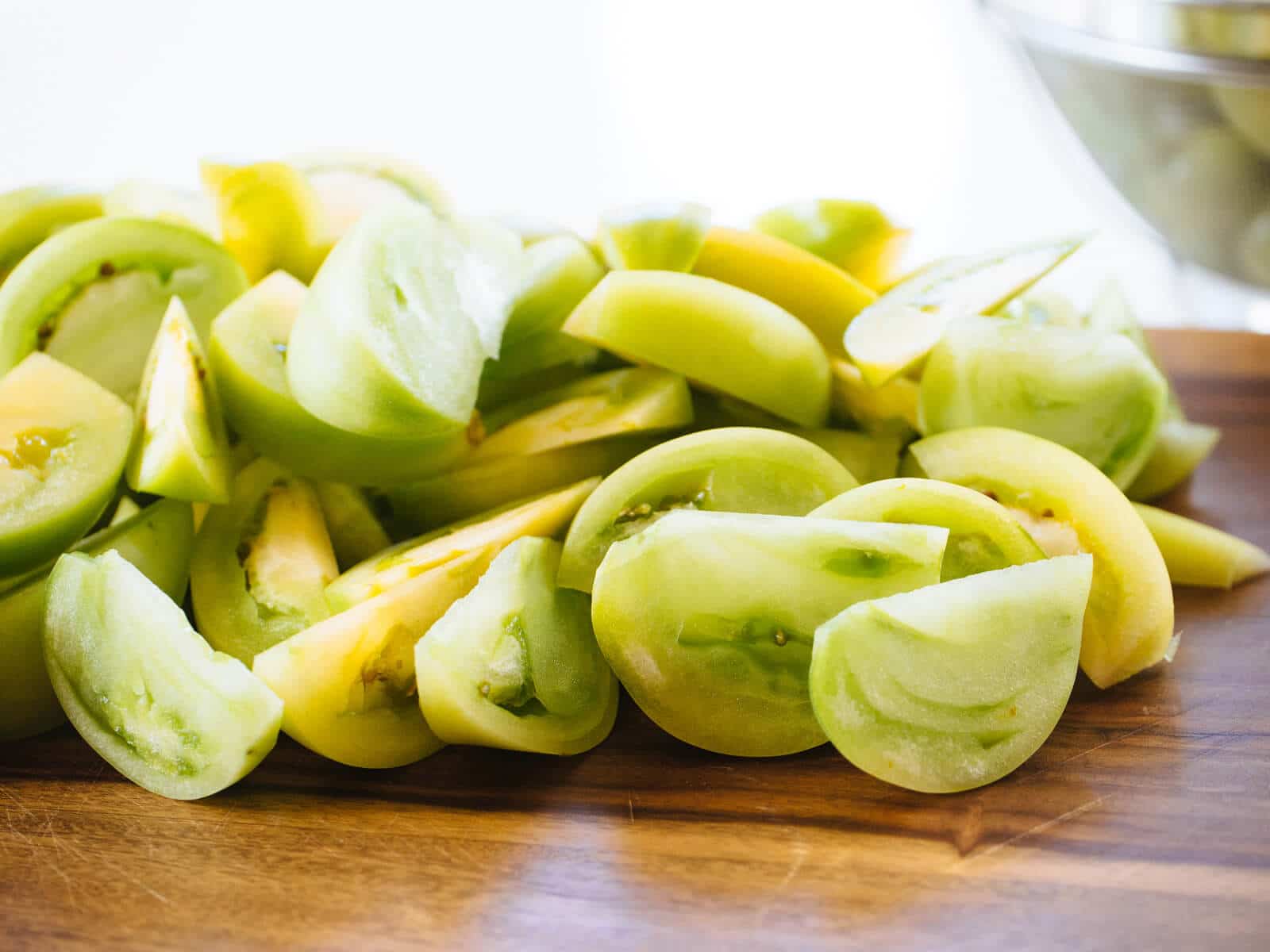
In a small saucepan, bring all of the brine ingredients to a boil and stir until the salt is dissolved. Remove the brine from heat.
Fill a hot, clean quart jar with the pickling spice mix of your choice. Pack the jar tightly with the tomatoes.
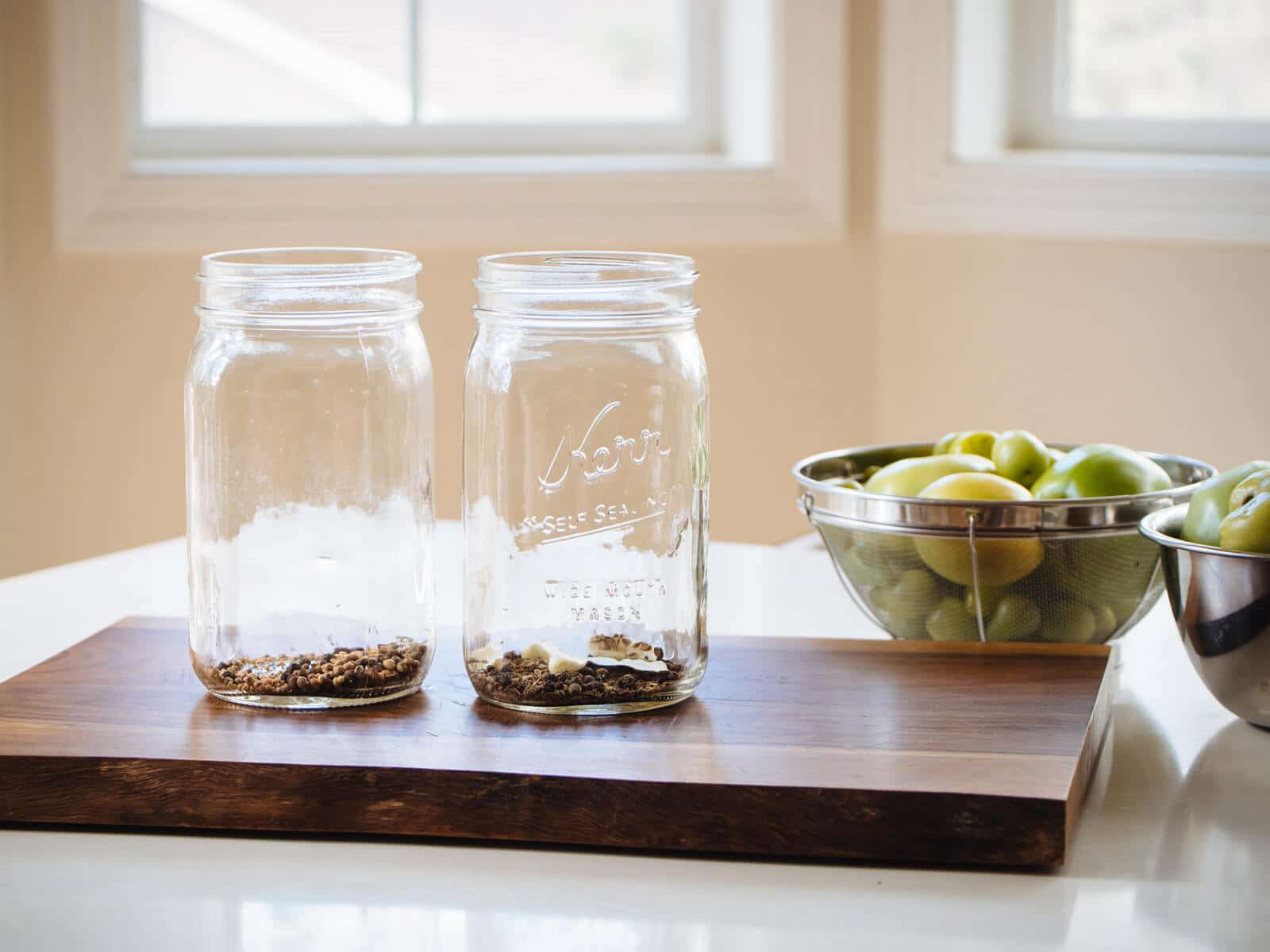
Pour the hot brine over the tomatoes, covering them completely and leaving 1/2 inch headspace.
Stick a chopstick or “bubbling” tool into the jar and move it around to release any trapped air bubbles.
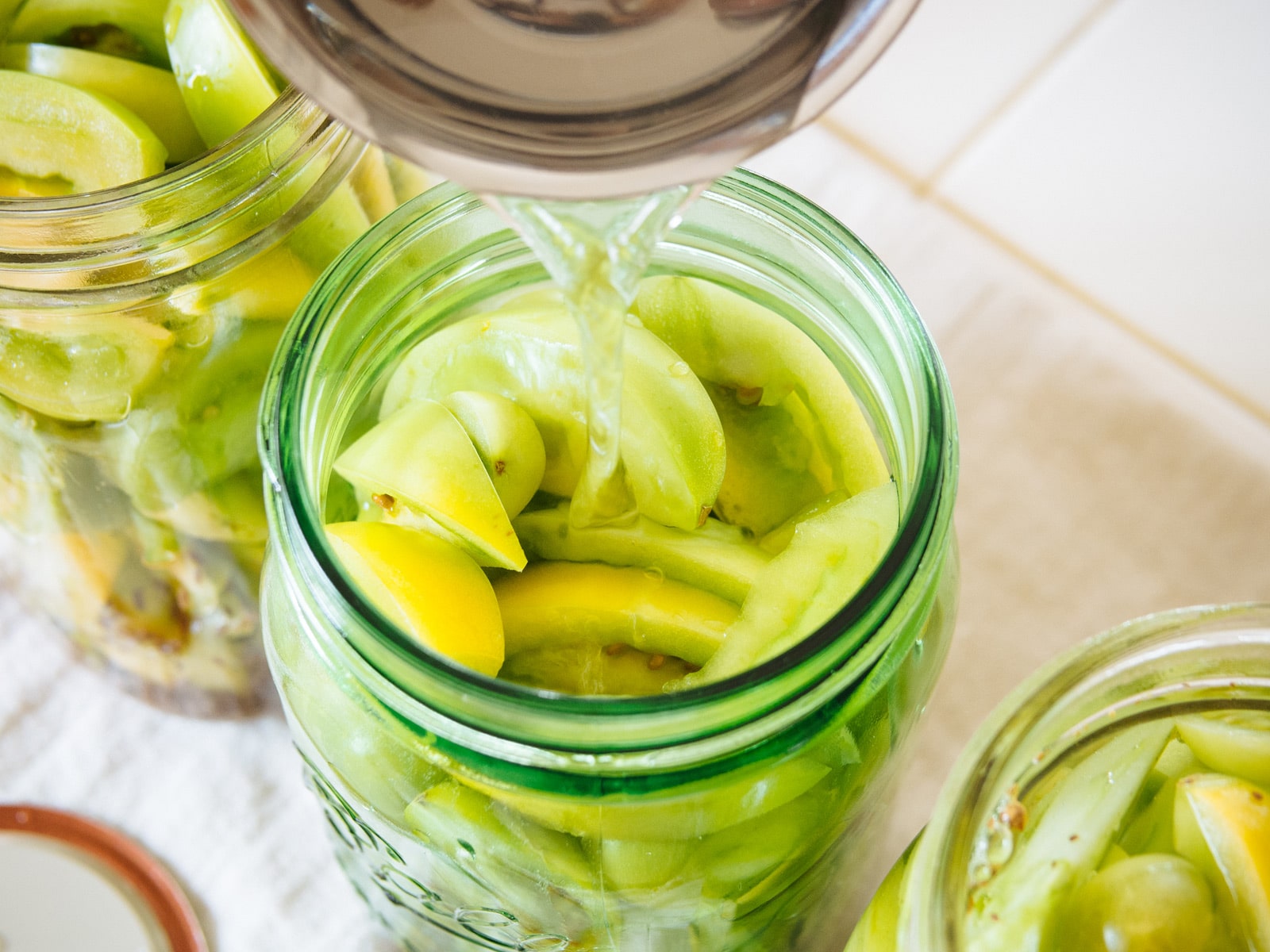
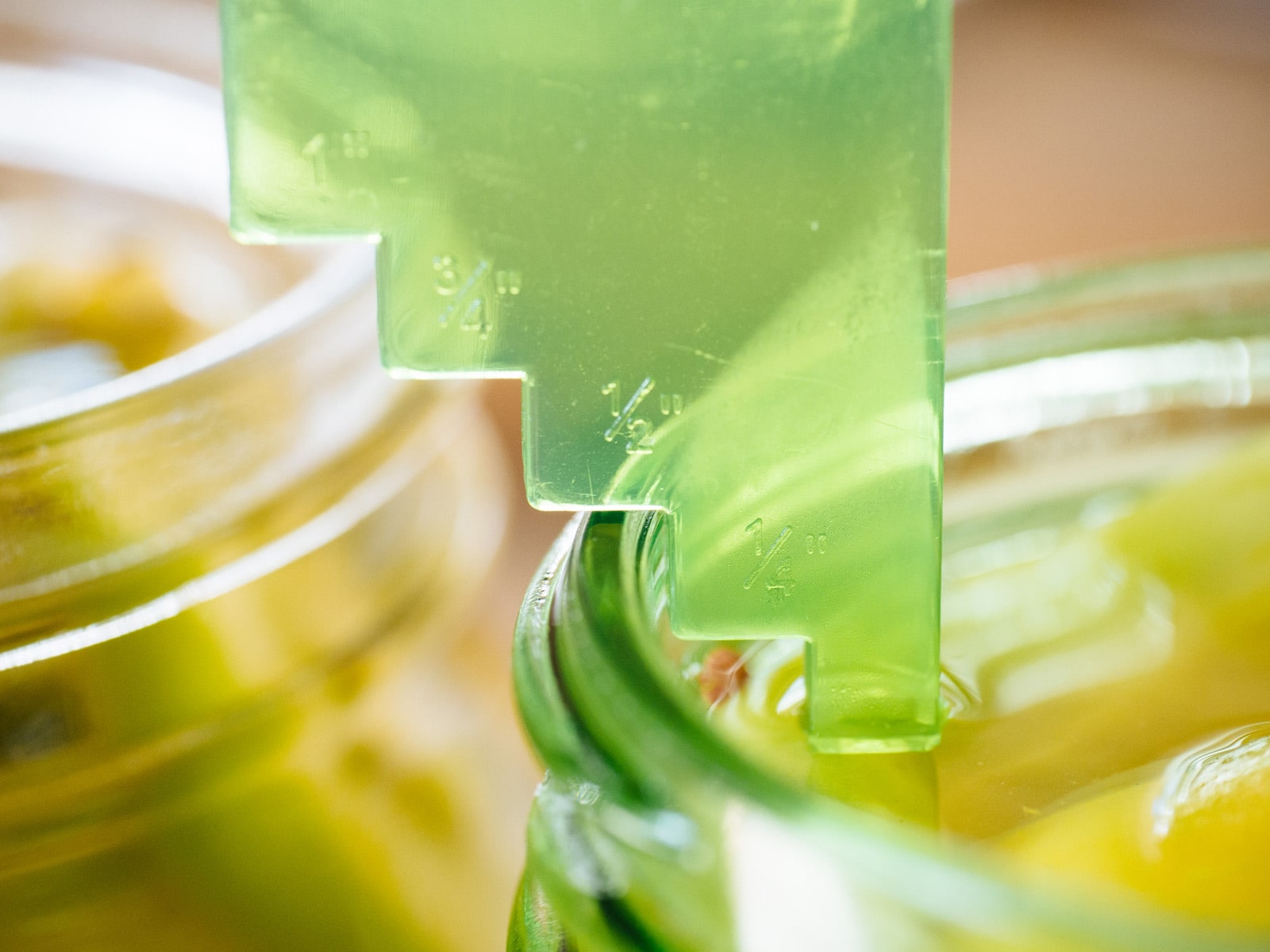
Wipe the rim clean, seal with a lid and band, and process in a boiling water bath for 15 minutes (adjusting the time for altitude as needed).
Quick tip: Due to limited space on my stovetop, I now use this electric water bath canner and I wish I’d found it sooner!
Canning often takes up all the space in my kitchen so no one else can cook while I’m in there. The electric canner makes it possible for me to move the water bath process to the end of a kitchen counter, dining table, patio, or anywhere I have access to a plug.
In the summer, I like to set up my canning station outside so I can also enjoy some fresh air while keeping the house cooler.
There’s a drain spout on the side so you don’t have to lift a huge, heavy pot to pour it out, but this spout is also great for dispensing drinks.
If you need to make a large batch of a hot beverage (spiced apple cider, for instance), you can heat it up in the canner and use it as a convenient, mess-free serving station (no more ladles going in and out of a slow cooker). Such a plus in my party book!
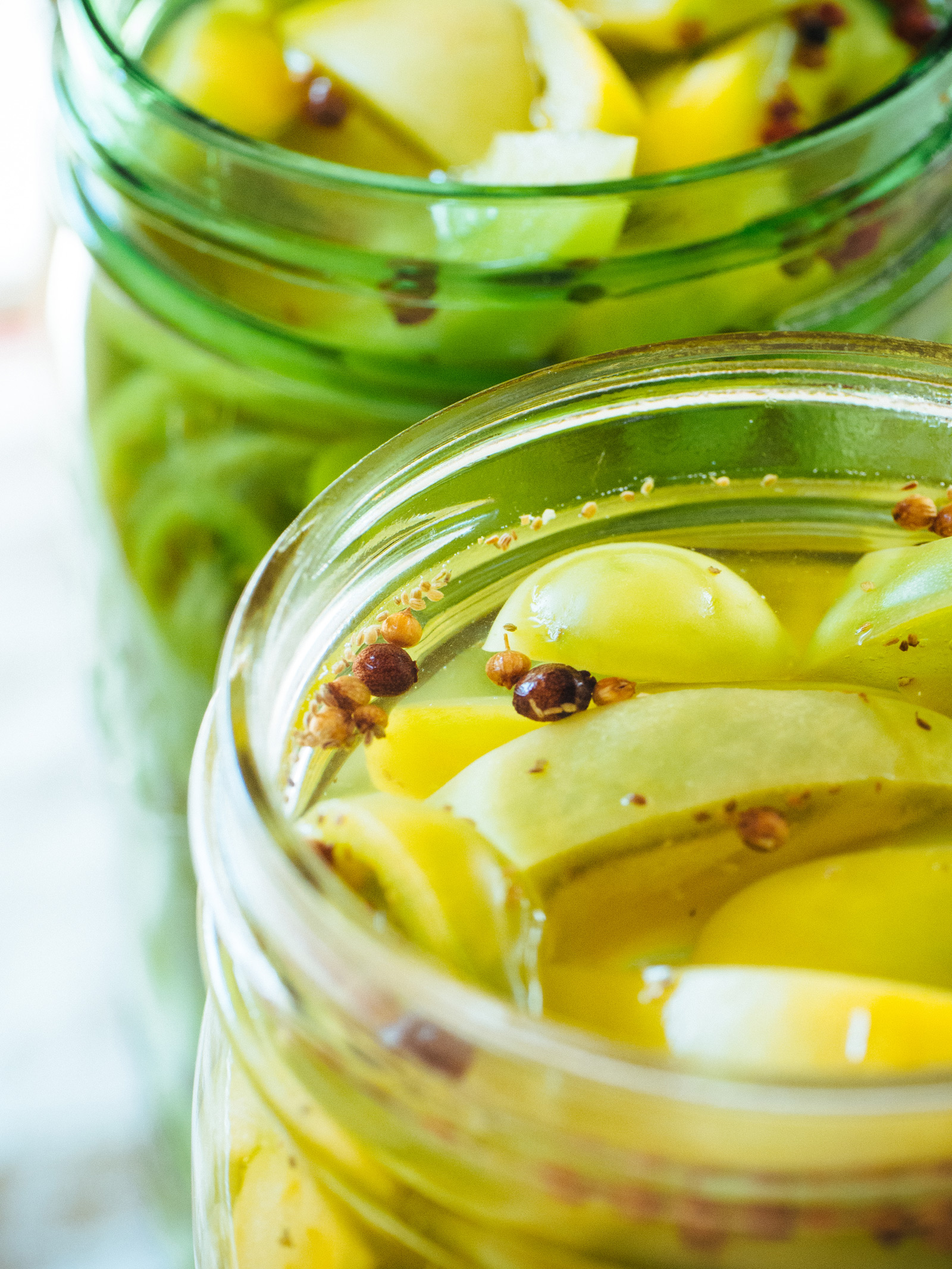
Store the jar in a cool, dark place. The green tomatoes will be perfectly pickled in about two weeks.
Add them to sandwiches, hot dogs, burgers, steaks, potatoes, or anywhere you would normally use relish. For a unique kick, you can even top off a Bloody Mary or dirty martini with a pickled green tomato garnish!
Recipe notes
* Szechuan peppercorns can be found at well-stocked Chinese or Vietnamese supermarkets in the spice aisle.
** When making curried and pickled green tomatoes, bring the brine ingredients, brown sugar, and curry powder to a boil. Stir until the spices dissolve completely. Fill a hot, clean quart jar with cumin seeds, whole allspice, and ginger coins; pack the jar with tomatoes; then pour the hot brine mixture over the tomatoes.

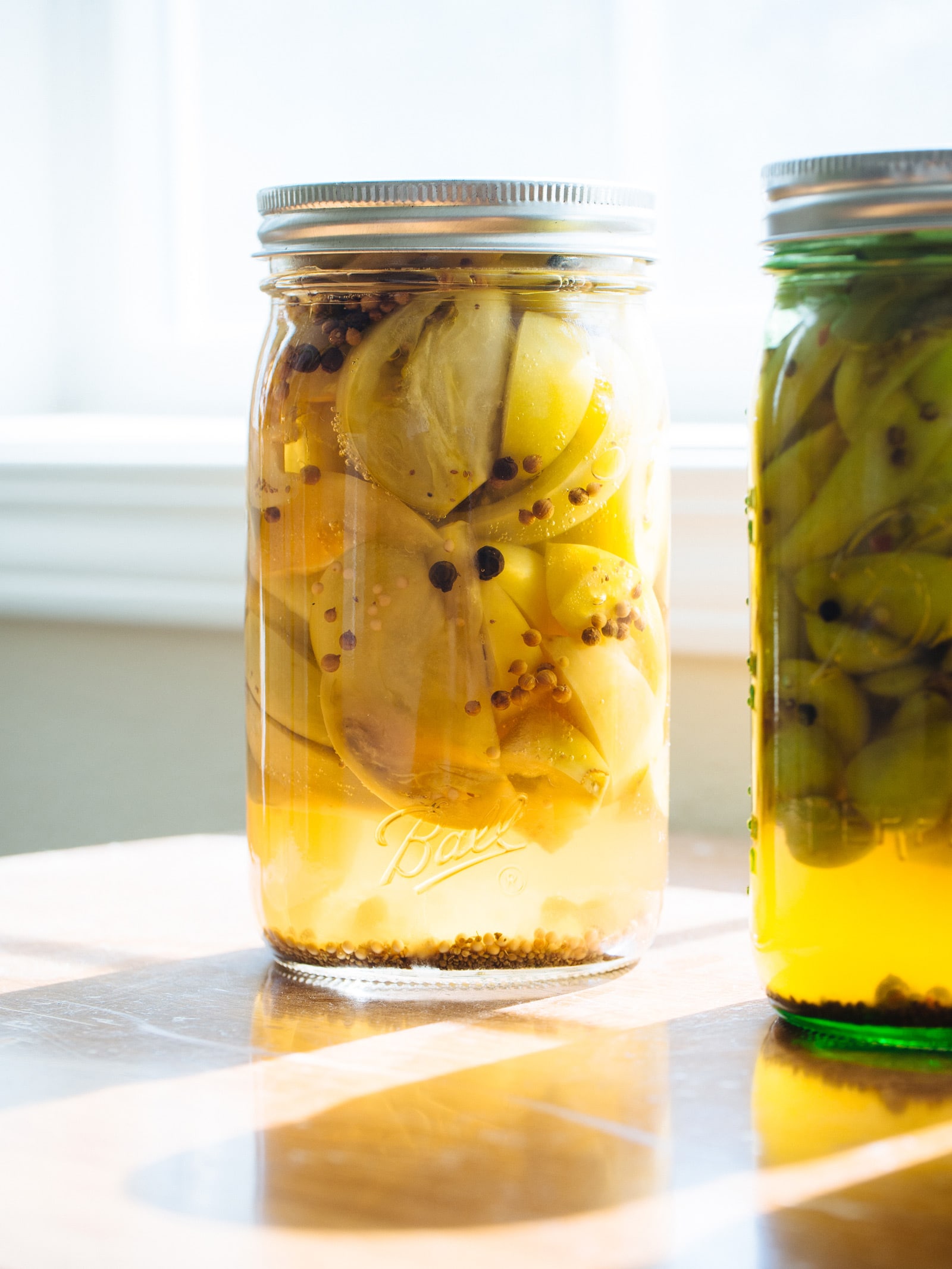
Common questions about green tomatoes
Is it safe to eat green tomatoes raw?
Absolutely! Green tomatoes (as well as tomato leaves) are edible, raw or cooked. They’re completely safe to eat and—contrary to popular belief—no part of a tomato plant is poisonous.
As with any vegetable, the key is consuming green tomatoes in moderation (especially if you’re sensitive to acidic foods or nightshades).
What do green tomatoes taste like?
Green unripe tomatoes are tart, acidic, and slightly astringent, depending on how young the tomatoes are. They have a firm, crunchy texture, and lack the juiciness of mature tomatoes.
While green tomatoes can be eaten raw, their astringency mellows out when cooked or canned.
What’s the difference between a green tomato and an unripe tomato?
Certain heirloom varieties of tomatoes (such as Green Zebras) start out green on the vine, and stay green when fully ripe. As they mature, their flavor sweetens, their pulp softens, and they become juicier inside, all while remaining green outside.
Unripe tomatoes (across all varieties) start out green as well, but turn any shade of pink, red, yellow, orange, purple, or black as they develop.
My pickled green tomato recipes use green unripe tomatoes, as their natural tartness complements the punchy flavors in pickling spices.
How can I get my pickled green tomatoes to stay crunchy after canning?
If these pickled green tomatoes are too soft for your liking after going through a boiling water bath, try skipping the boiling water bath and making them as quick pickles instead.
Simply pour the hot brine over the tomatoes and spices, let the jar cool at room temperature, and store in the fridge.
Or, you can add Pickle Crisp (food-grade calcium chloride) to your jar, following the recommended package amounts.
If your pickled green tomatoes are mushy, the problem may be in the quality of green tomatoes used. Always start with firm, fresh, unripe tomatoes that were harvested before the first frost. (A freeze will turn tomatoes mushy, even if they appear fine on the outside.)
Unripe tomatoes left on the counter for a few days will also begin the process of ripening (and softening), so it’s best to use them as soon as you pick them.
What do you do with pickled green tomatoes?
Here are some of my favorite ways to use pickled green tomatoes in my everyday cooking:
- Charcuterie and appetizer boards
- Potato and pasta salads
- Macaroni salads
- Green salads
- Salad dressings
- Burgers and hot dogs
- Sandwiches and wraps (particularly Mediterranean-inspired wraps)
- Tacos
- Rice and noodle bowls
- Bloody Mary cocktails and dirty martinis
I also have lots of suggestions for using the leftover pickle brine here!
Where to buy pickling and canning supplies
[show_shopthepost_widget id=”3309699″]
Ball Wide-Mouth Quart Jars | Ball 4-Piece Canning Utensil Set | Ball FreshTech Electric Water Bath Canner
4 Ways to Pickled Green Tomatoes
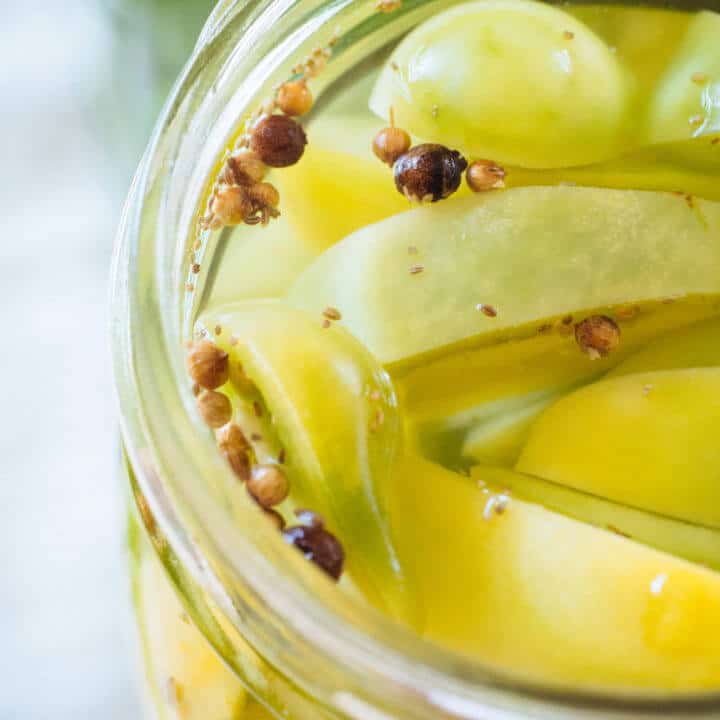
Turn an excess of green, unripe tomatoes into pickled green tomatoes with your choice of four different pickling brines.
Ingredients
- 1 pound green slicing tomatoes (or 1 1/2 pounds green cherry tomatoes)
For the Brine
- 1 cup white distilled vinegar (5% acidity)
- 1 cup water
- 1 tablespoon kosher salt
Basic Pickling Spice Mix
- 1 teaspoon yellow mustard seeds
- 1 teaspoon celery seeds
- 1 teaspoon coriander seeds
- 1/2 teaspoon black peppercorns
- 1/2 teaspoon whole allspice
Dilly Garlicky Pickling Spice Mix
- 2 teaspoons dill seeds
- 1 teaspoon black peppercorns
- 1 bay leaf
- 4 garlic cloves, peeled
Hot 'n Spicy Pickling Spice Mix
- 1 teaspoon black peppercorns
- 1 teaspoon Szechuan peppercorns *
- 1 teaspoon brown mustard seeds
- 1/2 teaspoon coriander seeds
- 1/2 teaspoon red pepper flakes
Curried Pickling Spice Mix **
- 1/4 cup packed brown sugar
- 1 teaspoon curry powder
- 1/4 teaspoon cumin seeds
- 1/4 teaspoon whole allspice
- 3/4 inch fresh ginger, sliced into thin coins
Instructions
- Cut larger (slicing) tomatoes into 1/2-inch wedges, and cut smaller (cherry or grape) tomatoes in half.
- In a small saucepan, bring all of the brine ingredients to a boil and stir until the salt is dissolved. Remove the brine from heat.
- Fill a hot, clean quart jar with the pickling spice mix of your choice. Pack the jar tightly with the tomatoes.
- Pour the hot brine over the tomatoes, covering them completely and leaving 1/2 inch headspace. Stick a chopstick or "bubbling" tool into the jar and move it around to release any trapped air bubbles.
- Wipe the rim clean, seal with a lid and band, and process in a boiling water bath for 15 minutes (adjusting the time for altitude as needed).
- Store the jar in a cool, dark place. The green tomatoes will be perfectly pickled in about two weeks. Add to sandwiches, hot dogs, burgers, steaks, potatoes, or anywhere you would normally use relish. For a unique kick, you can even top off a Bloody Mary or dirty martini with a pickled green tomato garnish!
Notes
* Szechuan peppercorns can be found at well-stocked Chinese or Vietnamese supermarkets in the spice aisle.
** When making Curried Pickled Green Tomatoes, bring the brine ingredients, brown sugar, and curry powder to a boil. Stir until the spices dissolve completely. Fill a hot, clean quart jar with cumin seeds, whole allspice, and ginger; pack the jar with tomatoes; then pour the hot brine mixture over the tomatoes.
Nutrition Information:
Yield:
8Serving Size:
1/2 cupAmount Per Serving: Calories: 47Total Fat: 0gSaturated Fat: 0gTrans Fat: 0gUnsaturated Fat: 0gCholesterol: 0mgSodium: 815mgCarbohydrates: 10gFiber: 1gSugar: 7gProtein: 1g
Nutrition information isn’t always accurate.
This post updated from an article that originally appeared on August 29, 2011.
More green tomato recipes you might like:
View the Web Story on pickled green tomatoes.


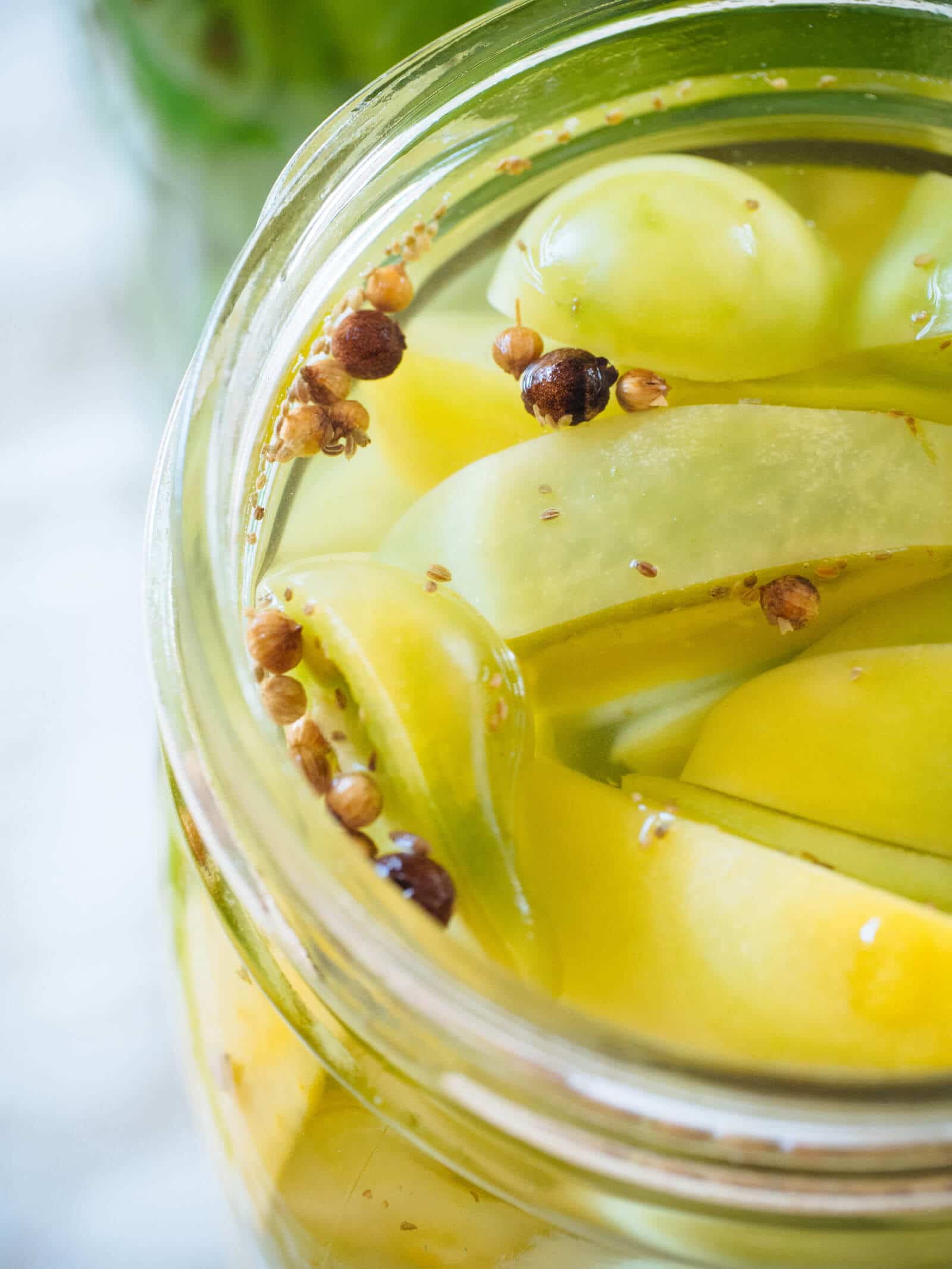
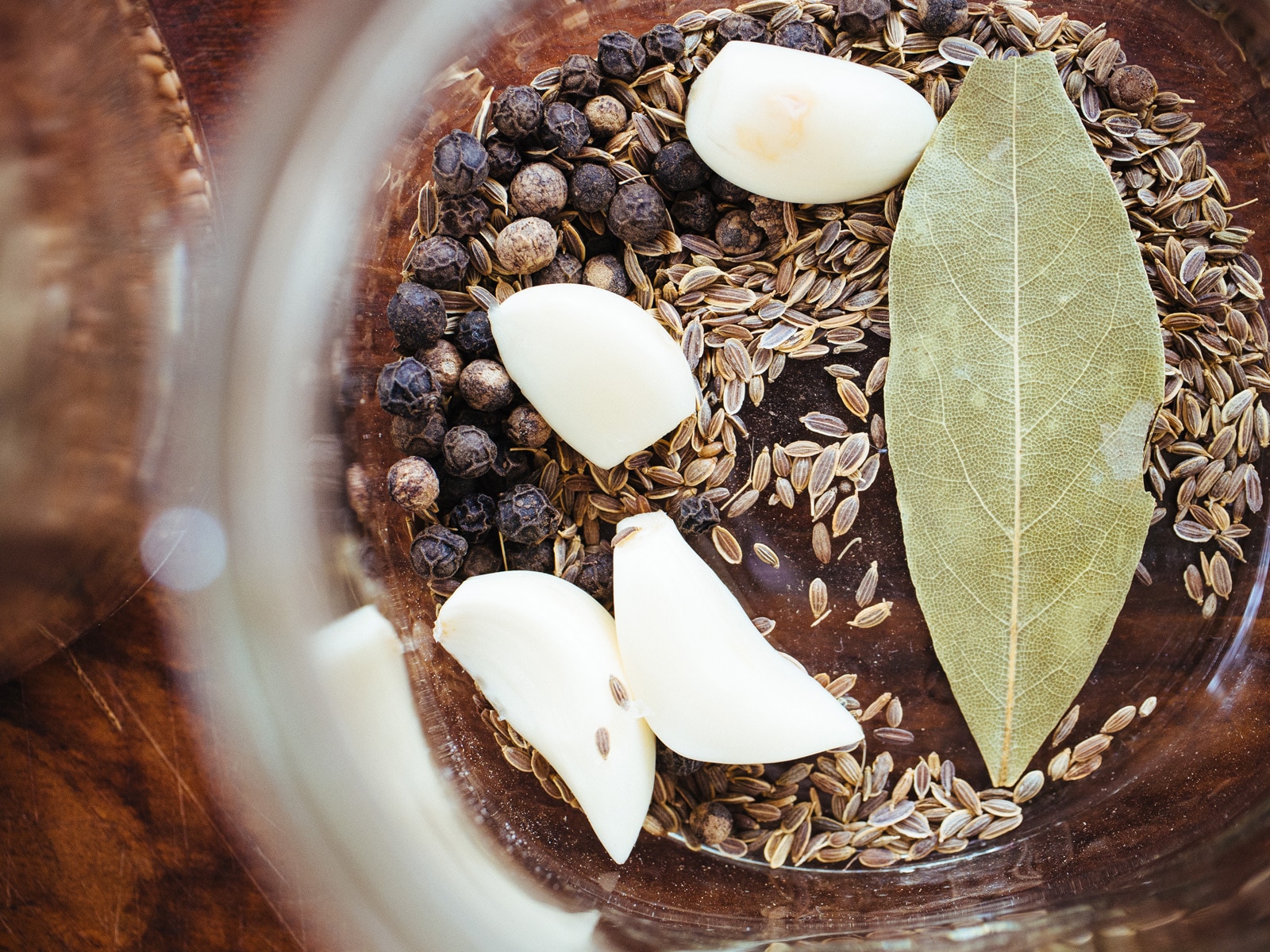
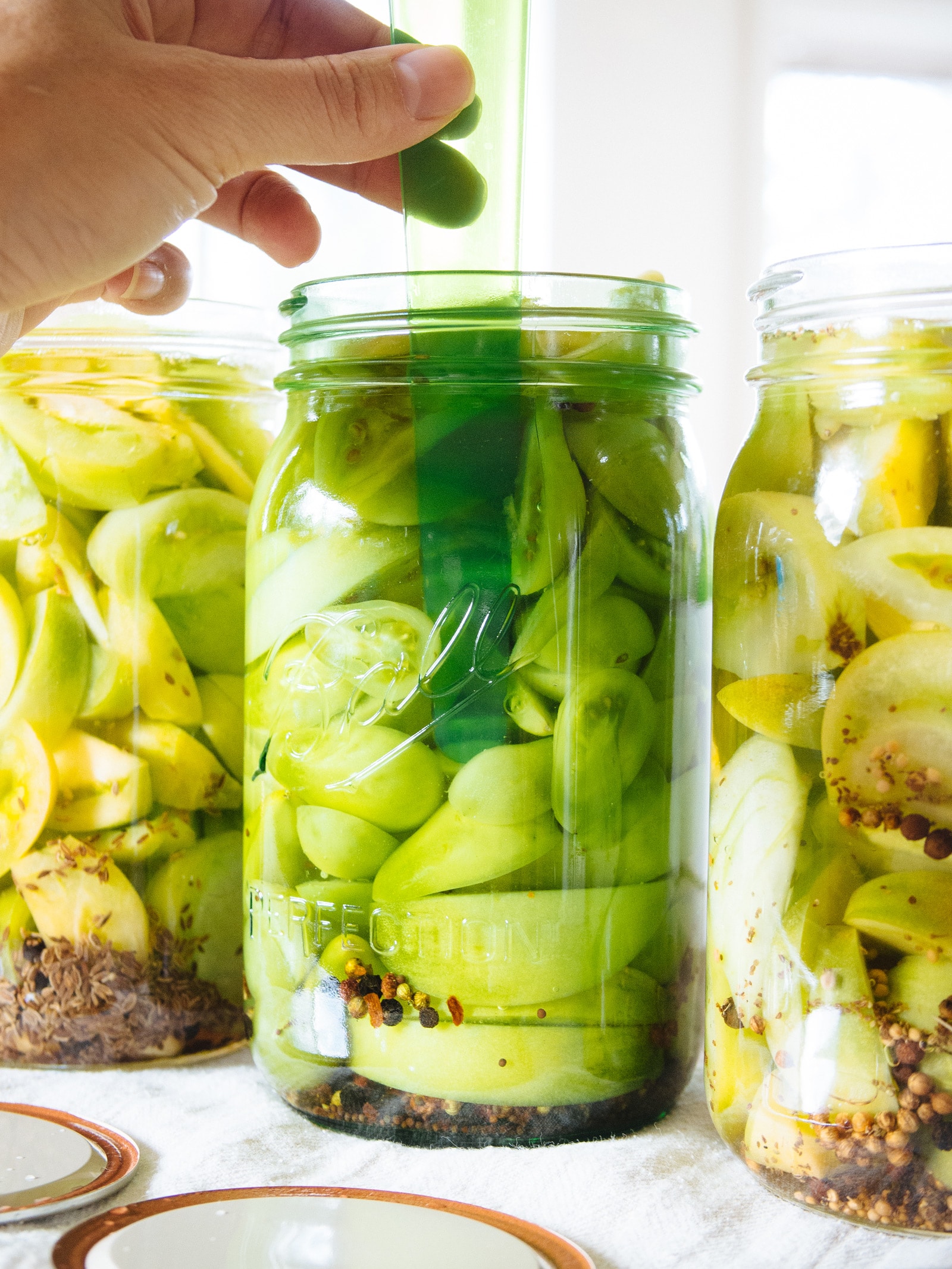
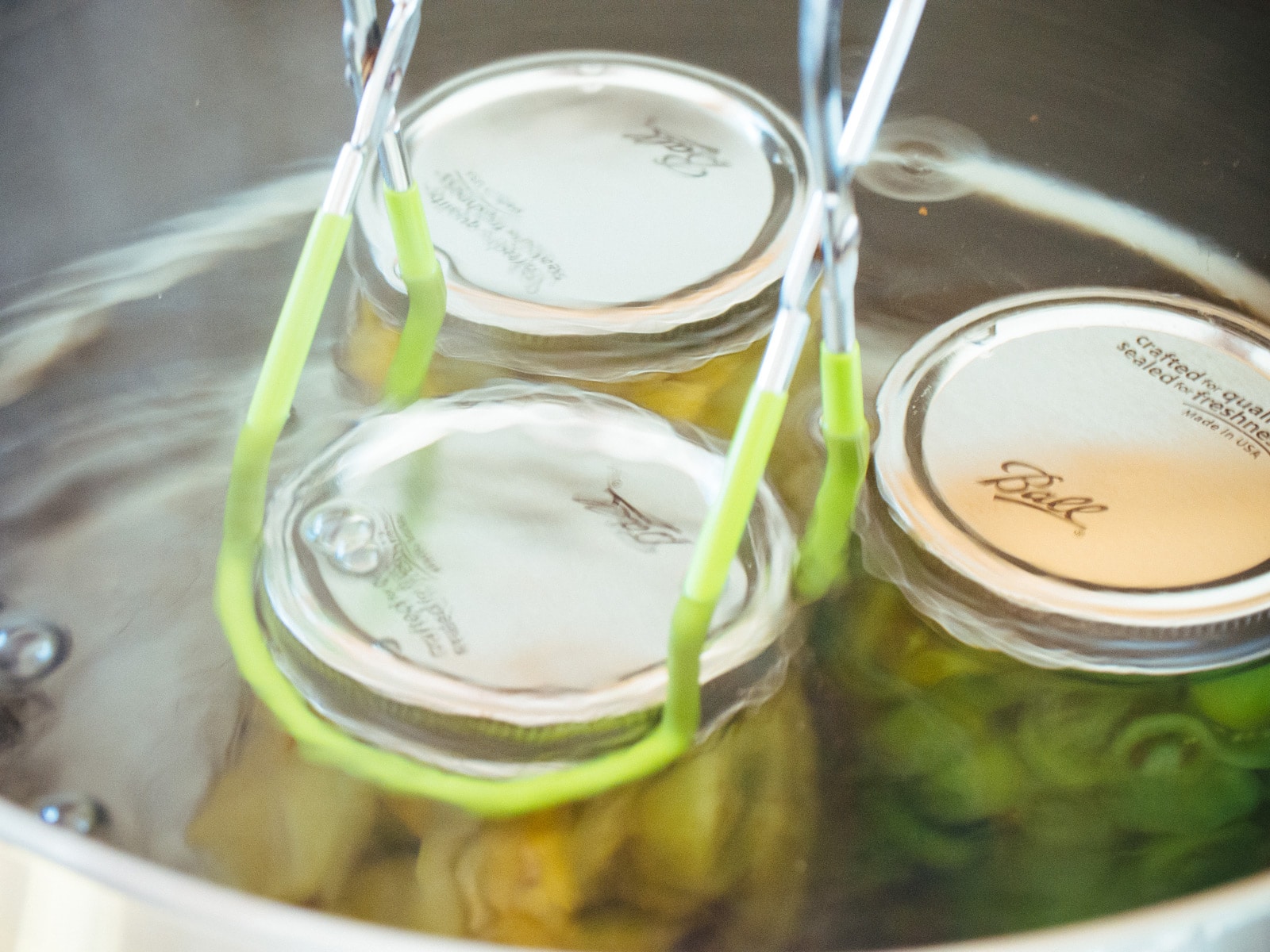













Always love doing this with my green tomatoes…of any size/variety! My favorite thing about them though is different than anyone else’s reasons for loving them, because my dad, who passed in ’08, was named Tom Pick…so that’s always been my nickname for them 🙂
Hi,
I’ve got a glut of green cherry toms from the garden this year and I’m looking at picking them using this recipe. At one stage it says to -“Fill a hot, clean quart jar with the pickling spice mix of your choice”. Sorry if this is a silly question but how do I make the quart jars hot? There’s no instruction for that. It’s probably pretty obvious but I’ve never done this before.
You boil your jars in water bath for like 10 mins to sterlize them with the covers and rings
If you don’t have a canner like Jess is referring to, a quick DIY way to put them in half-pint jars, fill up a deep pot (like one for pasta), put a metal trivet or similar in the bottom of the pot, and use tongs to lower the jars into it. Another thing that I love to do with green tomatoes is make green tomato bread – lots of good recipes out there for that!
As you bring your canning pot up to temperature, you can submerge your jars inside and let the water heat them up. Or, you can put the jars through a heated dishwasher cycle right before you start canning (so they come out still hot). I’ve also heard of people using their oven to heat their jars (though I personally haven’t tried this). I imagine the warming setting should suffice. You don’t need to sterilize the jars; the purpose of this is to prevent thermal shock when you fill the glass jars with hot brine. Hope this helps!
I am glad to find recipes for green tomatoes, I am trying the pickles now. Will update this in 2 weeks.
Thank you for trying this recipe! I hope you like it!
i tried the basic and i found them to be very soft and very vinegary. ones i have had at jewish deli are still firm did i do something wrong?
I never use cherry tomatoes, I use regular tomatoes and quarter them and they stay pretty firm.
No, these pickles are meant to be on the softer side. If you like yours firm, you can skip the boiling water bath and simply refrigerate the jar. It won’t be shelf stable like the canned version, but will last a very long time because of the vinegar. Speaking of which, do not reduce the amount of vinegar called for in the recipe; it’s needed for acidity.
What altitude is this recipe written for?
Sea level.
I tried the Basic Pickling spice mix and it was HORRIBLE. I’m so sorry to say that. Not trying to be mean but I’m trying to help someone who is new to bottling green tomatoes. I would highly recommend NOT using that recipe.
I’m sorry you did not have good results with that recipe. Flavor-wise, it’s best if you use fresh whole spices.
Pickled green tomatoes aren’t for everyone. While I like traditional pickling spice for other things, I like her hot/spicy and curried variations better – plus it’s a nice surprise on a charcuterie board!
Hiya, can I substitute dried dill weed for the dill seeds? Having a hard time finding them. Thanks!
Yes, but dill weed has a more subtle flavor than dill seed. I suggest starting with the same amount in your first batch (so in this case, 2 teaspoons dill weed) and decide if you want to use a larger quantity in future pickles. Keep in mind that dill weed will also alter the appearance of your pickles, as the dried leaves will mostly float to the top and cling to the tomatoes.
Your recipes look amazing! Can I substitute the vinegar for Apple Cider Vin? If you don’t remove the bubbles will it ruin the batch?
Yes you can, but using apple cider vinegar will add a sweetness to the pickles. Not removing the air bubbles in each jar won’t necessarily ruin the batch, but it may affect the lid’s ability to seal properly since it could add too much headspace.
Thanks for the recipe… I only hav green romas in the garden. Would you use that and how would be recommend cutting the tomato?
You can use any tomatoes you have. With romas, I recommend quartering them lengthwise, slicing them into 1/2-inch wedges, or slicing them crosswise into 1/2-inch rings.
I had green tomato pickles a few weeks ago and really liked them. What a lot of tomatoes you had. Great.
Made these and they were good but a bit soft for me. Mom loved them. I’m going to try again and use grape leafs for crispness. Wish me luck!
So glad you like them! These pickles are meant to be softer because of the boiling water bath. You can try them as refrigerator pickles next time (just letting them sit in the fridge for 2-3 weeks without canning) for a firmer texture. Or maybe try using Pickle Crisp?
can I use powdered cumin instead of cumin seeds? if so. what is the equivalent conversion seeds to powder. thanks
jd
Sorry for the late response! Yes, you can use ground cumin but will need to boil it with the brine ingredients to dissolve it. (Keep in mind the brine will be cloudy because of the powder.) I recommend using half the amount of ground cumin (so for each quart, 1/8 teaspoon ground cumin).
How long is the self life of pickeled green tomatoes?
Standard shelf life of canned goods is around 1 year if stored properly, but the texture and quality does start to decline over time. Also, if keeping home-canned products for longer than a year, be sure to check the seal on your lids often as they’re more prone to failing the longer they sit.
Once opened should these be refrigerated or will the vinegar still keep them stable?
They should be refrigerated once opened.
I eaten pickled green cherries without it being cut up. The gentleman what brought just marvelous pickles to church pot luck told me to use my fav pickling recipe & do nothing else with the tomatoes but pickle like you do any vegetable.
I am wanting to process in pint jars instead of quart. Does the process time change?
The processing time is the same for pints or quarts.
The tomatoes tend to float and it is hard to get them completely covered with the brine. Will they be OK if a small fraction of tomato is above the brine?
As long as they’re properly canned in the water bath, they’ll be shelf stable. You can periodically give the jar a shake to make sure all the tomatoes are infused with brine.
Turn the can upside down for a day or two then turn back.
Do I have to add lemon juice to the jars so the tomatoes don’t go bad after canning?
Correct. The lemon juice raises the acidity for safe canning.
I do not see lemon juice listed as an ingredient. Did I miss something?
My mistake, I thought the previous comment was referring to another recipe. No,
you do not need to add lemon juice. The vinegar in the brine makes this
acidic enough for safe canning.
My mistake, I thought this comment was referring to another recipe. (I answer comments held in a moderation queue, not on the page itself.) No, you do not need to add lemon juice. The vinegar in the brine makes this acidic enough for safe canning.
can green tomatoes be pickled in a cold pack method?? I use Dill pickle mix and just fill the jars with assorted veggies and pour the bubbling brine over into the jars and let them seal on their own when they cool down. been doing it that way for 4 yrs but have never tried doing green tomatoes.
Hi, this recipe IS for cold-pack pickles. The cold-pack method still requires water bath canning for safe long-term storage, but you can certainly do it your way and refrigerate any jars that don’t properly seal.
Dan, I do the same thing. Then check the jars to insure they seal. If a jar doesn’t seal, I put it in the fridge. I put the sealed jars on a shelf and put in the fridge after opening. The pickles are a lot crispier using this method.
Do tomatoes prepared in such a manner ferment and yield probiotics? By early-October I am always overwhelmed my a cornucopia of green tomatoes. I ferment cabbage and pickles and would love to add to these great sources of probiotics.
These are vinegar-based pickles, so they will not ferment. However, tomatoes CAN be fermented using standard fermentation methods.
Tried this. ended up with 6 jars of very mushy tomatoes. Inedible. 15 minutes?
The processing time is correct for quart-size jars (processed at sea level). These pickled green tomatoes are not meant to be crisp, they should be soft but still pleasant. Different factors can affect the outcome, including the quality of tomatoes you started with, how much water they contained, even your definition of “very mushy.” If you prefer crisp pickles, you can skip the processing and turn them into refrigerator pickles. You can also try adding Pickle Crisp (calcium chloride) to your next batch, but I’m uncertain how that would turn out as I’ve never used it for tomatoes.
Hot brine and green maters don’t mix… use cold brine and refrigerate. .I’ve eaten them 10 months later and still great. Lots of dill and lots of jalepenos is the way to go. Or just lots of dill..
Hi Linda. We loved your recipe but found it a little too vinegary for cucumbers/pickles. Do you think it is safe to reduced the vinegar to 3/4 of a cup instead of 1? Thank you.
It’s not safe canning practice to reduce the vinegar. However, if you eat the pickles right away after canning, it should keep in the fridge for a week or so (that’s a conservative estimate).
First time I’ve been to your site, and I’m just an old southern boy. So I don’t mean to insult any of your fans that post here, but come on. The recipes I’ve read here are about as plan and simple as any I’ve seen anywhere. People, slow down, read the directions, and thank Miss Linda for all she’s done to share some very good recipes with us. I thank you for it all Linda…….Tim
I appreciate the kind words, Tim! And welcome!
I was just thinking the same thing, and I’m a Yankee boy. Lol. (Although my granddaddy was born and raised in Lynchburg TN and I have a few kinfolk down there.) People just don’t seem to take the time to actually read things from Once upon a time to The End anymore.
I prefer to leave the cherry tomatoes whole. Is there a way to do this?
Yes, you can leave your cherry tomatoes whole (you just won’t be able to fit as many in the jar).
poke a few holes in the tomatoes first so that the brine can really get in there 🙂
Last question. The brown sugar did not dissolve till after I processed them and noticed it at the bottom. Total crisis or ok? This is my first attempt at pickeling
The sugar was supposed to be boiled in the brine until it dissolved (as stated in the directions). The flavor might be a bit uneven but it’s not a crisis. If your jar sealed properly, the pickles will last a long time but should ideally be used within 1 year for optimal quality. If you wanted these pickles crisp, simply store the jar in the fridge without processing it.
yeah i saw that note after i finished haha….flash backs from every teacher i ever head went through my head….read everything before you start:-)
awesome thanks!!!!
Also how long will these keep?
Properly canned and unopened, about 1 year.
What would I do if I wanted to make these crispy
Pickle Crisp
Cold brine…no alum crap.
For crispy pickles: Soak sliced tomatoes for 24 hours in 2 gallons of water with 2 1/2 cups of lime (from grocery store). Wash well and then soak another 24 hours in 2 gallons of water with 1/2 pounds alum. Rinse again and soak for 6 hours in water with a box of ginger mixed in Then begin your recipe. This a a process that my grandmother would’ve called “trouble”, but it works and it’s worth it.
Thank you for the suggestion. Pickle Crisp (calcium chloride) is the commercial version of what you explain here, and should work as well.
Sorry. Saw the answer to my question from a prior poster.
No worries, enjoy your pickles. 🙂
Can you put the jars in the refrigerator and not do the processing?
Hi Linda,
I am looking for something to finish up the rest of the green tomatoes I have sitting around (I am drowning in chow chow and green tomato salsa verde). I am really interested in making the dilly version of these but I’m not much on canning in quarts , I just like the amount a pint gives me. How can I alter the recipe for pints? This is my first year canning and doing good so far! 🙂
Thanks!
You can simply halve the recipe ingredients to produce a pint. Processing time remains the same. Enjoy!
Thanks! It was the processing time I was worried about!!!
HI Linda
Love the blog. Can these recipes be used for other vegetables? Cucumbers in particular. Just entering summer down under!
Thanks
Yes, any of the pickling brines in any of my recipes (on this blog) can be used for other vegetables. I do have a bread and butter pickle recipe for cucumbers: http://gardenbetty.com/2012/09/bread-and-butter-pickles/ Enjoy!
Here is the recipe without the photos. Just highlight this text, copy it and then paste it into a new WORD document.
Four Ways to Pickled Green Tomatoes
Makes 1 quart
Ingredients
For every quart jar, you will need approximately 1 1/2 pounds of green cherry tomatoes.
For the Brine
1 cup white distilled vinegar (5% acidity)
1 cup water
1 tablespoon kosher salt
Basic Pickling Spice
1 teaspoon yellow mustard seeds
1 teaspoon celery seeds
1 teaspoon coriander seeds
1/2 teaspoon black peppercorns
1/2 teaspoon whole allspice
Dilly Garlicky Pickling Spice
2 teaspoons dill seeds
1 teaspoon black peppercorns
1 bay leaf
4 cloves garlic, peeled
Hot ‘n Spicy Pickling Spice
1 teaspoon black peppercorns
1 teaspoon Szechuan peppercorns *
1 teaspoon brown mustard seeds
1/2 teaspoon coriander seeds
1/2 teaspoon red pepper flakes
Curried Pickling Spice **
1 teaspoon curry powder
1/4 cup packed brown sugar
1/4 teaspoon cumin seeds
1/4 teaspoon whole allspice
3/4 inch fresh ginger root, sliced into thin coins
Method
Wash, dry, and slice cherry tomatoes in half.
In a saucepan, bring all the brine ingredients to a gentle boil.
Fill a hot, clean quart jar with the pickling spice mix of your choice. Funnel in the tomato halves and pack the jar tightly.
Pour the hot brine over the tomatoes, covering them completely and leaving 1/2-inch headspace. Stick a chopstick into the jar and move it around to release any trapped air bubbles (a process called “bubbling”).
Wipe the rim clean, seal with a lid and band, and process in a boiling water bath for 15 minutes (adjust time for altitude as needed).
Store the jar in a cool, dark place. The green tomatoes will be perfectly pickled in about three weeks. Add to sandwiches, hot dogs, burgers, steaks, potatoes, or anywhere you would normally use relish. For a unique kick, you can even top off a Bloody Mary or dirty martini with a pickled green tomato garnish!
* Szechuan peppercorns can be found at well-stocked Chinese or Vietnamese supermarkets in the spice aisle.
** When making curried and pickled green tomatoes, bring the brine ingredients, curry powder, and brown sugar to a boil. Stir until the spices dissolve completely. Fill a hot, clean quart jar with cumin seeds, whole allspice, and ginger coins; pack jar with tomatoes; then pour the hot brine mixture over the tomatoes.
Highlight the text from each section showing the directions on the recipe page and paste each section of the text in a WORD document, you don’t need to print all the pages with the photos. Just copy each section of text above the photos and put in in order in a new document,
I bought “pre made” pickling spice. How much would I put in the bottom of the jar? I was thinking about 1 tbsp. maybe?
A tablespoon per jar should be fine!
Just a question… I made the basic pickling recipe…. but didn’t do the warm water bath… Is that a problem?
Not a problem at all, just stick the jar in the fridge and it will keep for a very long time. The tomatoes will stay firm this way (though the texture does start to soften after a few months).
I’m really excited to make these but I’m finding it difficult to print off the recipe. 16 pages with all those pictures! Perhaps it would be useful to your readers to come up with a recipe card for printing purposes?
Printable recipes are on my to-do list, and I hope to implement them on the blog in the near future! I appreciate your patience!
Hi, I’m wondering if I can use the whole cherry tomato without cutting them in half? Thank you heather
Yes, you can leave them whole, just wouldn’t be able to pack as many into a jar.
Thank you very much for your recipes! My Grandma used to make green tomato pickles and since she has passed I have never been able to find a good recipe. I will use yours. I too am overflowing with green cherry tomatos! Thanks again
You’re welcome, I hope they turn out just as good as your grandma’s!
Could i use full size green tomatoes & chop them
In quartered or smaller wedges depending on the size of tomato?
Yes, I often do that with larger tomatoes. Just keep the wedges or slices thick enough (at least 1/2 inch) so they won’t break apart in the brine.
Oh my god! Not to dis your recipe but it’s not exactly written in the most organized way, as it really should be when canning! For the curried tomatoes, I forgot the salt in the brine, is there any way I can still add the salt after I have already processed them in the water bath?
Hi, the very first part of the ingredient list clearly states that salt is needed for the brine. With any recipe, it’s a good idea to gather all your ingredients first before you start.
In this particular brine (vinegar-based), the salt is for flavoring so you do not need to add it after the fact (unless you want to). Either way, you should not process these pickles twice in a boiling water bath.
I think that the salt is not just for flavoring when pickling vegetables, it’s more for creating a hostile environment that microorganisms can’t grow in.
That would be true if you were using salt in a lacto-fermented pickle recipe; however in this recipe, the vinegar provides a hostile, acidic environment to inhibit bad bacteria. In vinegar-based pickling brines, the salt is not the key to safe food preservation. Just make sure you use distilled vinegar (5% acidity) and do not alter the amount of vinegar called for.
What I meant is that this recipe isn’t really set up in an orderly way. I have been canning for years now and know that a good canning recipe should always be written in an organized way to ensure that all the proper canning/sterilizing procedures are done by the letter. For the sake of your subscribers, you should consider writing the recipes out so that the steps are in a more organized way.
Printable one-page recipes are a feature I hope to implement on the site in the near future!
As for proper canning/sterilizing procedures, it is assumed that readers know the basics of boiling water bath canning before beginning.
I know how to can, I’ve been canning for years, and after trying a lot of canning recipes, I noticed this particular recipe is not as organized as it should be. Albeit, most of the recipes I’ve used have been Ball recipes or recipes from the National Home Preservation Association etc. Their canning recipes are extremely incremental, which is no doubt to ensure the best end product.
Umm, brine means ‘salt in water’.
If you forgot it, hey that happens to the best of us but it’s pretty clearly laid out.